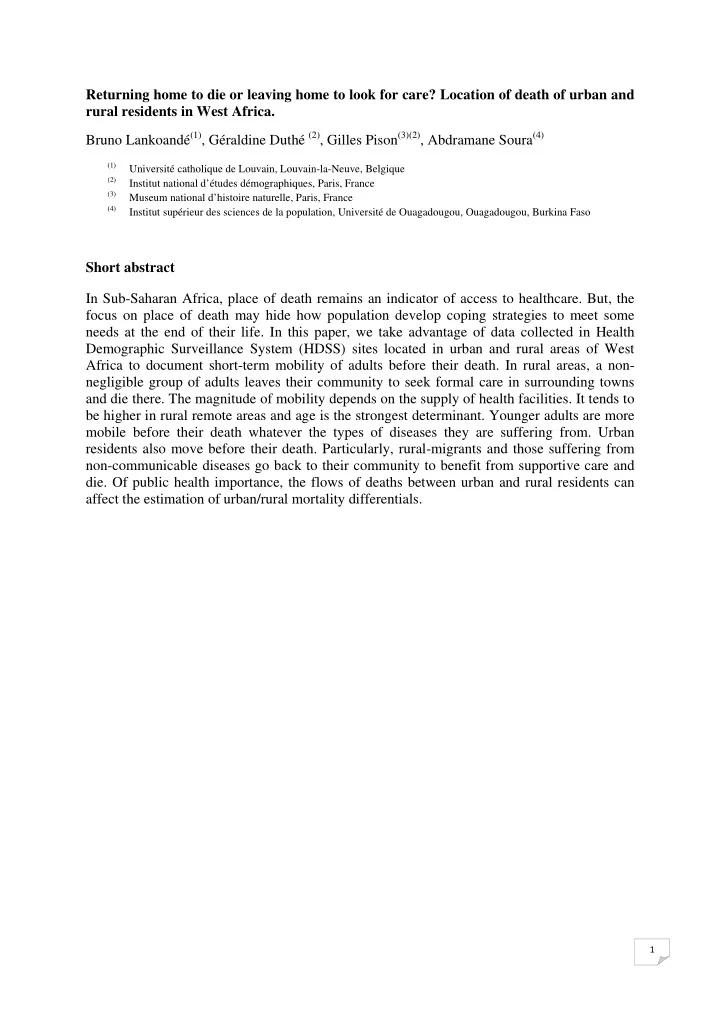

Returning home to die or leaving home to look for care? Location of death of urban and rural residents in West Africa. Bruno Lankoandé (1) , Géraldine Duthé (2) , Gilles Pison (3)(2) , Abdramane Soura (4) (1) Université catholique de Louvain, Louvain-la-Neuve, Belgique (2) Institut national d’études démographiques, Paris, France (3) Museum national d’histoire naturelle, Paris, France (4) Institut supérieur des sciences de la population, Université de Ouagadougou, Ouagadougou, Burkina Faso Short abstract In Sub-Saharan Africa, place of death remains an indicator of access to healthcare. But, the focus on place of death may hide how population develop coping strategies to meet some needs at the end of their life. In this paper, we take advantage of data collected in Health Demographic Surveillance System (HDSS) sites located in urban and rural areas of West Africa to document short-term mobility of adults before their death. In rural areas, a non- negligible group of adults leaves their community to seek formal care in surrounding towns and die there. The magnitude of mobility depends on the supply of health facilities. It tends to be higher in rural remote areas and age is the strongest determinant. Younger adults are more mobile before their death whatever the types of diseases they are suffering from. Urban residents also move before their death. Particularly, rural-migrants and those suffering from non-communicable diseases go back to their community to benefit from supportive care and die. Of public health importance, the flows of deaths between urban and rural residents can affect the estimation of urban/rural mortality differentials. 1
1. Background According to Gu and her colleagues (2007), place of death goes through three evolutionary stages in societies. During the first stage, most people die at home because of poor access to healthcare resources. In a second stage, deaths in hospitals become more common due to medical advances. In the last stage, the emphasis is put on the quality of care at the end of life. The availability of home based care increases to meet people preferences to die at home. During the different stages, cultural norms play a role in determining one place of death. In developed countries, the debate in public health is particularly centered on place of death as an indicator of quality of end of life care with most people preferring to die at home compared to hospitals or care homes (Gomez et al., 2012). In some countries such as Japan, Belgium, a great share of deaths continue to occur at hospitals while in USA and Canada, death at home or in nursing homes have replaced death in hospitals (Houttekier et al., 2011; Gomes et al., 2008; Anezaki, 2008; Flory et al., 2004; Wilson et al., 2002).This variation in place of death between developed countries seems to reflect cultural preferences towards death and most importantly differences in availability of out-of-hospitals care resources for dying persons. Referring to the transition model of Gu and al. (2007), we assume that less developed countries are still in stage 1 or in transition from stage 1 to 2. In sub-Saharan Africa (SSA) particularly, place of death reflects more cultural preferences and access to healthcare than quality of end of life care. Population still face serious health issues including the rise of non- communicable diseases in a context of persisting infectious diseases and poverty (Remais et al., 2012). Thus, prevention and cure of diseases remain the priority. Terminal care is quasi inexistent except in countries which were very affected by the HIV epidemic such as Zimbabwe, Uganda, South Africa, Kenya (Gysels et al., 2011). It is believed that most deaths occur at home even though the lack of complete vital registration systems hampers extensive research on this issue. A few population based studies have examined place of death in recent years. Among adults, proportion of death occurring in hospitals vary from 28% at Addis Ababa to 50% in Zambia (Anteneh et al., 2013; Chisumpa et al., 2017). This figure was estimated at 50% for all ages in a semi-urban setting of Burkina Faso (Bado et al; 2016). In Botswana where the completeness of the vital registration system is acceptable, 60% of adults death occur in hospitals (Lazenby et al., 2010). It is recognized that socio-demographic, clinical, and ecological factors have an impact on place of death (Chisumpa et al., 2017; Houttekier et al., 2009; Cardenas-Turanzas et al., 2011). According to the Behavioral Model of Health Services Utilization developed by Phillips et al. (1998), socio-demographic factors such as age, gender, marital status and education impacts on the ability to look for care. For instance in the African context, aging may be considered as a cause of death and this prevent elderly (or the relatives) to seek care (Duthé et al. , 2010). As found in Addis Abeba and Botswana, elderly are more likely to die at home compared to young adults (Anteneh et al., 2013, Lazenby et al.,2010). The clinical component in the analysis of place of death refers generally to the cause of death. In the model developed by Phillips et al. (1998), it contribute to define the need to look for care. The hypothesis is that some diseases such as cancer, renal failure, cardiovascular diseases are difficult to manage at home and will probably lead to hospitalization. Contrasting evidence on the association between cause of death and place of death appears from the limited research in sub-Saharan Africa. While cardio-vascular diseases tend to occur in health facility compared to HIV/AIDS in Addis Ababa, no association between place of death and cause of death was found in Zambia except with injuries and HIV/AIDS. Finally, place of residence and living standard are commonly used as a proxy of enabling characteristics to look for care. Place of 2
Recommend
More recommend